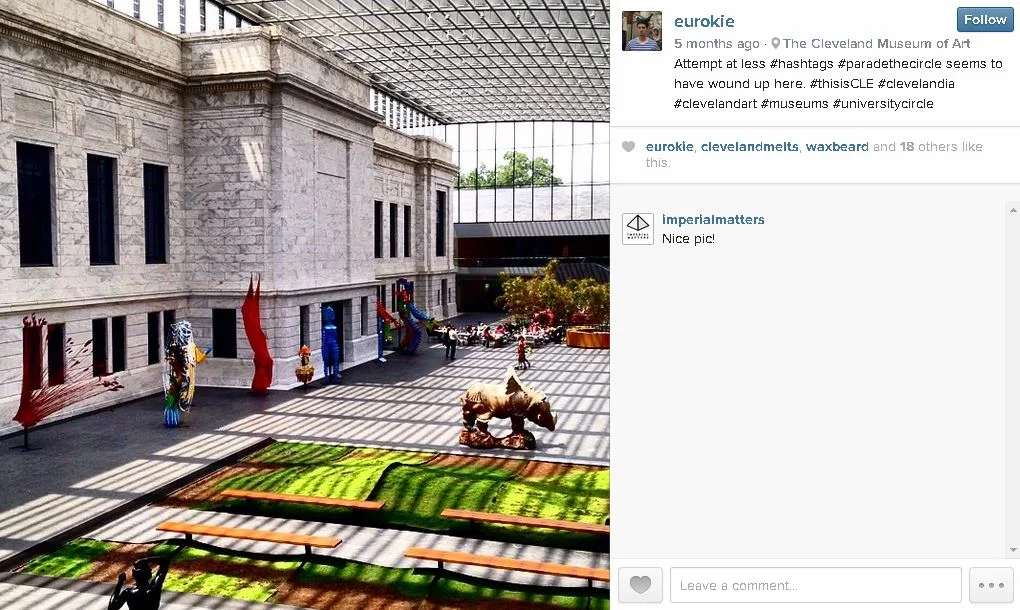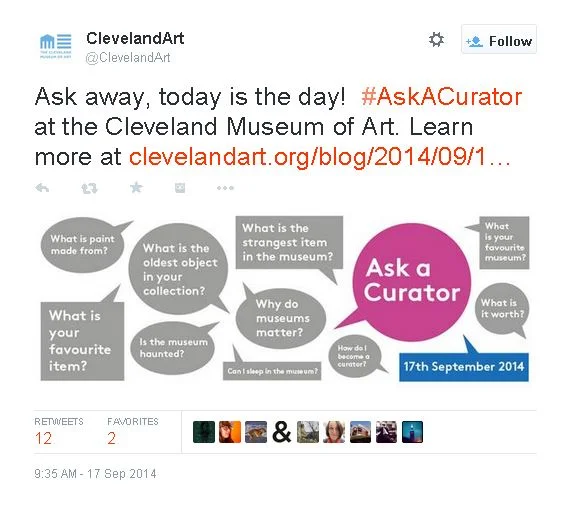In the second part of her interview, Reena S. Goodwin, the Digital Communications Manager at the Cleveland Museum of Art, expands on the use of social media for museum events, the challenges associated with social media, and making “connections with audiences, not for them.” Speaking with AMT Lab’s Kristen Sorek West, Ms. Goodwin offered the following observations:
- Gather expertise from different departments to showcase your organization’s capabilities and present the content from a different point of view.
- Diversify the form of your social media content to better illustrate and share your organization’s stories, as well as give your audience multiple ways to engage.
- Use social media as a means to have natural, full conversations with audiences. Through the exchange of views and ideas, art organizations can create authentic connections between the audiences, the organization, and the subject matter.
For the first part of the interview, please click here.
CMA's annual Parade the Circle event on full display in the museum's Atrium. Image hosted by the Cleveland Museum of Art and created by @eurokie on Instagram.
KSW: How do you envision social media being used throughout the Cleveland Museum of Art (CMA)?
RG: Word of mouth or word of mouse is so critical, and again, if we can harness social media while people are on-site, we get some of the most passionate reviews. According to a really interesting article I was recently sent, “38 surprising facts about trust in social media,” around 92% trust earned media, like social media, recommendations, and word of mouth more than advertising. The relationships we are building with current visitors have the potential to deepen and engage others outside of our immediate networks. Sometimes it just takes a reminder, or for us to ask a question. It would be great to one day have a place inside the museum that people can sit down, charge their phones, and be prompted to share their experience immediately on social media.
I also love what Art140 is doing. I went to their panel with MoMA at SXSW Interactive earlier this year, and they were just launching a project that encourages visitors to interpret works from their permanent collection with a hashtag, and have their responses funnel into a microsite.
KSW: Are you working with the Curatorial department on any projects?
RG: Definitely, they are some of our biggest content creators and for good reason. Just recently, the museum participated in “Ask a Curator” day on Twitter. We had about seven curators online answering audience questions. Our curators are often contributing to the museum’s blog, also, and our audiences always appreciate and love hearing from them.
Screen shot of the Cleveland Museum of Art's "Ask A Curator" Day on Twitter.
KSW: Do you have any recommendations for smaller organizations trying to incorporate social media in their programming or use in different ways?
RG: You can be a small organization in the real world but have a huge audience online. Social media can do that, it can take an audience from local to global. It’s so possible to reach more people in a month on social media than through your front doors. The opportunity to connect with those virtual visitors through a variety of mediums is tremendous. Emotion drives great art, and emotions are contagious. We have an opportunity – arguably a duty - to reach people with art, and do it in an authentic way. Digital communications helps make connections with audiences, not for them.
KSW: Could you elaborate on the process of making connections with visitors and not for them? Do you have any specific experiences to share?
RG: Depending on the organization and the project, the process can unfold in a multitude of different ways. For instance, we can upload an art-of-the-day photo with some commentary and ask people, “What do you think?” Ask the audience what their perspective is and to share their thoughts and their interpretation. Everyone has the potential to see things differently. We did something similar with our exhibition, Yoga the Art of Transformation. We asked viewers to tell us why they think yoga is an art. Those types of conversations were a great way to connect an emotional response back to an exhibition, even if you didn’t see it.
For our event Parade the Circle, we had participant photos take over the museums homepage for the duration of the event. We asked visitors to snap photos and post them to Instagram using a hashtag #paradethecircle. It became an instant gallery that allowed us to see the event through their eyes and see their feedback in real time. Using the hashtag made tracking this activity on Instagram even more manageable. The images were also broadcast on digital signs throughout the museums during the event so those inside could see the live stream as well. Overall, we collected about 1,500 pictures. We are using social media to make the museum more accessible and give visitors the opportunity to feel more a part of it, to make memories and to learn something, too. To inform people of the hashtag we put it on banners, postcards, and on social media. When we did a similar social media campaign at our event, Solstice, we stamped every attendee’s hand using stamps with the hashtag on it.

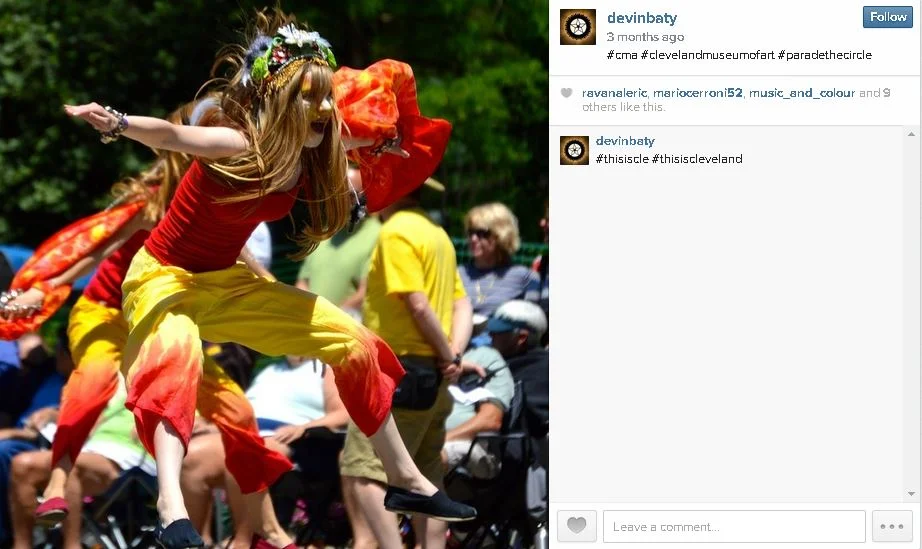
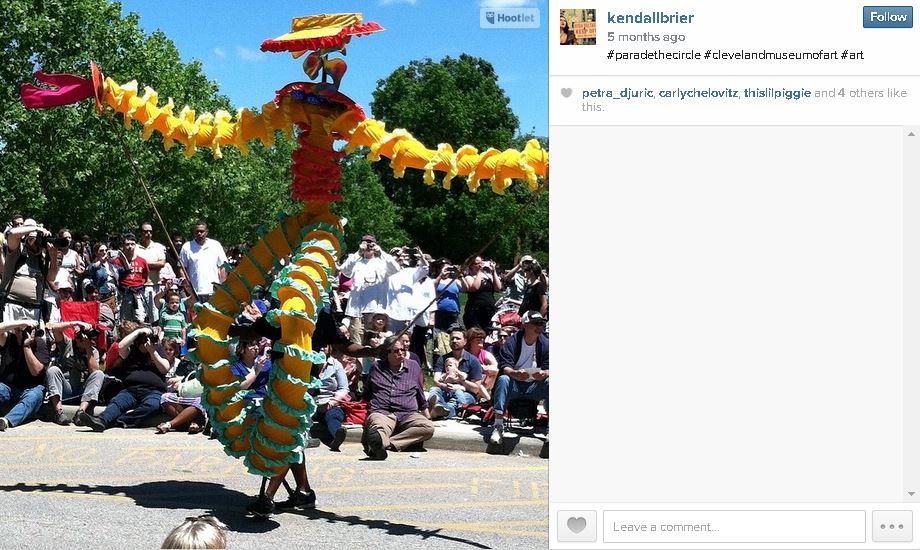
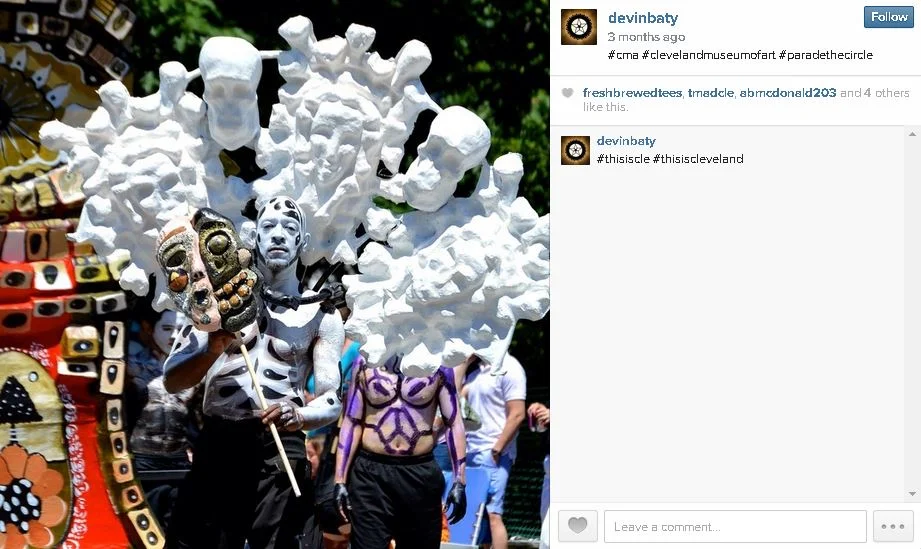
#paradethecircle images hosted by the Cleveland Museum of Art, provided by its Instagram followers.
KSW: How far in advance were postcards, advertising and social media promotions with the hashtag released prior to event?
RG: The post cards and posters went out about 4 weeks leading up to event. We gave the hashtag to artists and other organizations to use on social about 2-3 weeks before the event so they could share their behind-the-scenes process of building floats and puppets for the parade. Prior to Parade the Circle, the web team tested the transfer of images from Instagram to our website at a smaller, regular monthly event to make sure it would work.
KSW: How many CMA staffers belong to the social media team?
RG: It’s just me.
KSW: What do you wish you would have known relating to social media and other technology prior to using it?
RG: Social media is a powerful form of communication, and it simply uses technology to transmit that communication. I see them as distinct from one another but, of course, you can’t separate the two. Diving into social media, you have to be aware as a brand or business that there is a level of customer service expected. But, creativity is key. Trends come and go rather quickly, and in order to have good social media communications you have to have a lot of content to communicate. More and more people are consuming content, and more quickly. People are consuming video content more rapidly than any other type of online content. Great stories are key but you have to know where your opportunities are to illustrate and share it, and also know about how to diversify the form of your content.
I work off of an editorial calendar that tracks my activities but also what is happening within the museum. There is a level of planning involved, but sometimes spur-of-the-moment stories arise. Maybe it is a slow day at the museum so you have to identify stories that are appealing regardless of current events. Think outside of what happening in your world to connect to someone else’s. It’s also important not to live in a bubble. Don’t just speak about your world, but also listen. Based on what your organization can offer you can use what you hear to guide and adapt your content. Time management is also a challenge. It is easy to get carried away with work, but social media never sleeps. It is important to keep pace and stay topical.
KSW: Have you had any surprising feedback, audience or donor reactions, or press coverage relating to the CMA’s social media activity?
RG: I can’t speak for our donors, but I think the staff was very pleased with Solstice and Parade the Circle initiatives. Often people see the value but perhaps not the extent of the value. Sometimes they see the reach numbers, like 1,500 people uploading photos to Instagram, but may not understand what that activity actually means. Often metrics like reach or potential reach measure a specific action people have taken, like buying a ticket, but the action here was engagement. Connections are valuable.
KSW: What do you think the future of social media and art integration looks like?
RG: It’s hard to tell, but if I had to predict, I think increased accessibility through digital communication with the art, contemporary artists, and curators will become more integral.


